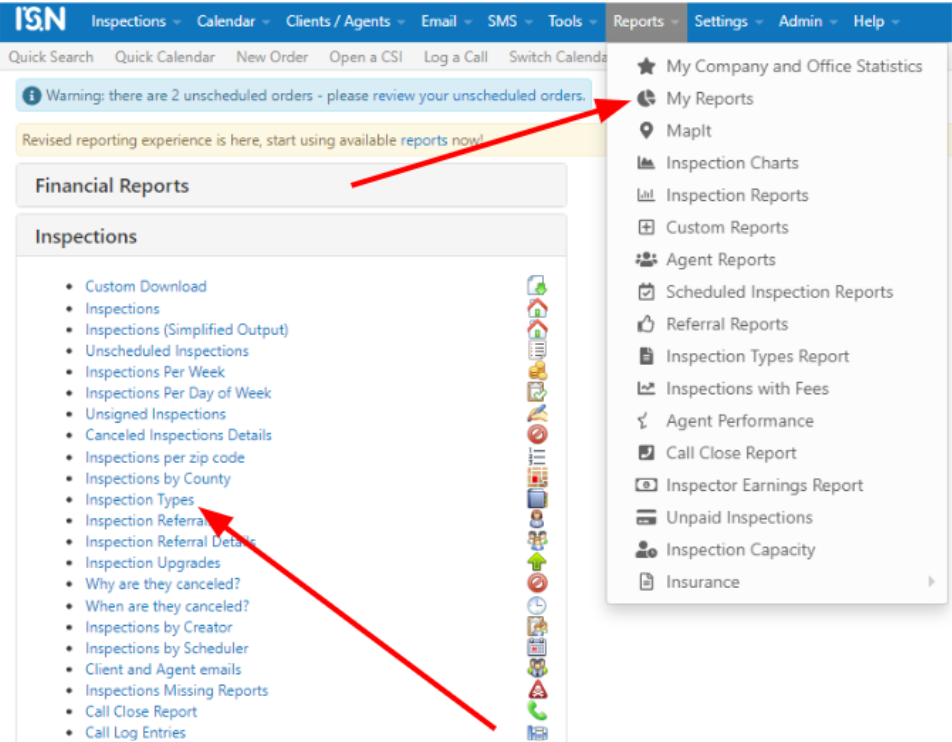Running a home inspection business isn’t just about doing more inspections – it’s about making data-driven decisions to improve performance, increase revenue, and stay ahead of the competition.
With so much data available, where should you focus? Tracking the right business metrics helps you understand what’s working, what’s not, and what adjustments you need to make to keep growing.
The metrics that actually matter
Not all data is useful. If you want to scale your business, focus on these key numbers instead:
1. Inspection volume – Are you booking more jobs month over month?
Your inspection volume tells you how well your business is growing. If you see an increase in bookings every quarter (you can build a report for this in ISN), your marketing and referrals are working. If your numbers are stagnant or declining, it’s time to take a closer look at what’s happening.
- Slow growth? You may need to invest more in marketing, follow up with past clients and agents, or improve referral business
- Busy one month, slow the next? Seasonal fluctuations are normal, but if you’re seeing big swings, consider promotions or targeted outreach to fill gaps in your calendar
- Fully booked but still struggling with revenue? It might not be a volume problem – it could be a pricing issue (which leads to the next metric)
With ISN’s automated reports, you can easily track inspection volume, revenue trends, and business growth – no spreadsheets required.
2. Average inspection fee – Are your prices competitive?
Your pricing should reflect your expertise, market demand, and the value you provide. If your average inspection fee is too low, you may be leaving money on the table.
- Are your prices competitive with the local market? They should match what others are charging while still reflecting your experience and the value you bring
- Are you consistently booked out weeks in advance? If so, there might be room to increase your rates – high demand means you could afford to charge more
- Are clients frequently choosing lower-cost competitors? If so, revisit your pricing strategy and consider offering packages or add-ons to provide more value
ISN’s financial insights let you see how your pricing stacks up over time and identify opportunities for revenue growth without the guesswork.
3. Revenue per inspection – Are you maximizing each job?
It’s not just about how many inspections you’re doing – it’s about how much you’re making per job and type of job. Adding ancillary services like radon testing, mold inspections, or sewer scopes can increase your per-inspection revenue without adding more appointments to your schedule.
- Track which add-ons are most popular. If clients repeatedly request certain services, promote them more
- Offer bundled packages. This makes it easier for clients to opt into multiple services, increasing revenue without extra effort
4. Referral rate – Are clients and agents sending business your way?
Your best source of new business should be your past clients and real estate agents. If referrals aren’t bringing in steady work, you may need to:
- Strengthen relationships with agents by keeping reports easy to understand and offering excellent customer service
- Ask for reviews and testimonials – happy clients are usually willing to recommend you, but they may need a reminder
ISN’s agent and client tracking and reporting tools make it easy to see where your referrals are coming from so you can track which agents refer the most business and nurture those relationships.
5. Cancellation rate – Are you losing business before the inspection happens?
A high cancellation rate can be a red flag. Here’s what it could mean:
- Confusing pre-inspection communication – Clients might not fully understand what they’re getting
- Pricing concerns – If cancellations jump after they hear your fee, there may be a disconnect between price and perceived value
- Scheduling conflicts – Clients may go with another inspector who’s available sooner
If cancellations are a recurring problem, adjusting your communication, pricing, or scheduling policies can help reduce last-minute drop-offs.
6. Marketing metrics – Are your emails doing anything?
This metric is crucial. If you’re sending emails but not tracking engagement, you’re flying blind. Your email marketing should be actively driving business – not just filling inboxes.
- Are your emails being delivered? If not, your email list may need cleaning
- Are they being opened? If not, test new subject lines
A good email strategy keeps you top of mind, reminds agents and past clients to send referrals, and fills your calendar with repeat business. ISN’s built-in email automation tools help you track engagement and improve your outreach.
The bottom line
Keeping an eye on the right numbers helps you stay ahead of slow months, fine-tune pricing, and focus on what’s actually driving your business forward. Whether it’s spotting trends, improving referrals, tracking what matters makes growth a whole lot easier.
The goal isn’t to just stay busy – it’s to build a business that runs smoother, earns more, and keeps getting better.
Want more stories from real inspectors working in the industry? Be sure to subscribe to The Ride Along newsletter to get all the latest episodes delivered straight to your inbox!

